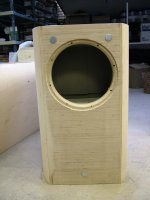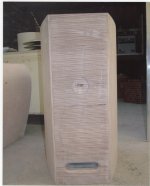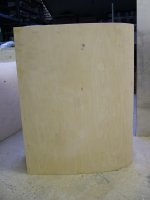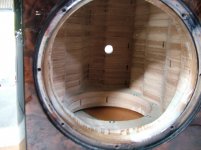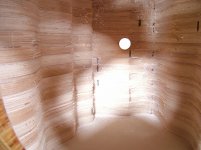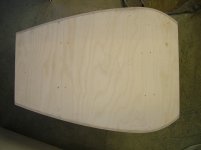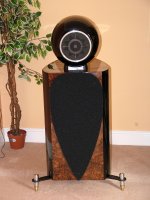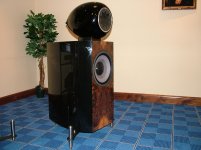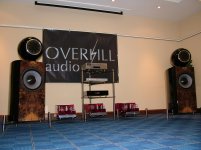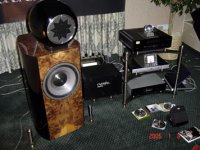IMHO you can get small FRs as good for less money.
dave
I missed which driver that was as good for less. Would that be the cousin paper cone tc9fd at less than half the cost? Or was it an FRxx?
Sorry for not responding earlier
Thanks Haraldo
Oh yes eq. is nessesary. Not that much, but absolutely nessesary.
The one with Aura sound is eq. by a Behringer deq96 and is palying in my HT room. Does a good job here. Crossed over to 4x 10" subwoofers @120Hz and aided in the top by a 19mm ring radiator.
The Vifa source is my main reference speaker. Eventually I will mate it with a IB subwoofer as it cannot play loud enough in the bottom octave to my taste.
I use Audiolense to eq. it and room correct at the same time.
These are amazing speakers!!!
The best I have had. A little trick:
Put a little Isopunkt made thinner with turpentine on the paper cones and let oit harden in UV light. Takes them a step up in clarity and definition.
It is closed boxes both of them.
The alu boxes are actually a little too small, but when the subs are ready, makes no problems.
They play insanely loud when crossed over about 80-100 Hz.
Koldby
So the point of the Isopunkt is to make the cone a bit heavier? Not stiffer I presume? Dit you just paint on the mixed down Isopunkt?
Merry Christmas by the way
I tried to find more info on Isopunkt and ran across this article, which has some interesting observations on the big picture of hifi setups and a little bit on what Isopunkt does. This guy is a diy nut, he weaves his own suspensions from nylon fishline, glues coins on the backs of tweeter magnets, makes shims to smooth out surfaces where possible, etc. One trick after another. Anyhow, it sounds like Isopunkt is simply roofing tar and adds mass and elasticity to hard cones. I would be surprised if we could get it easily in the US, but probably equivalents in roofing business.
http://www.google.com/url?sa=t&rct=...j4CgAw&usg=AFQjCNF2CyfY_LTIldIon6KTq_7S0gy-TQ
Merry X-mas and Happy Holidays folks
http://www.google.com/url?sa=t&rct=...j4CgAw&usg=AFQjCNF2CyfY_LTIldIon6KTq_7S0gy-TQ
Merry X-mas and Happy Holidays folks

Last edited:
I got a stash of BB/BB quality Baltic Birch ready, now all I need is time  .
.
I had some aluminium water yet cut for templates and the feet for the speakers. I'll update with pictures if I finally find some time to work on it.
I'm still wondering if I should use wooden dowels to stack my multiply or run threaded M8 rods all the way trough.
The enclosures will be sealed with epoxy or fibreglass, would it be save to run a rod from top to bottom? Possibly with rubber rings under the nuts to allow some expansion/schrinking. I'm not that sure the sealed enclosures will not expand or contract after sealing with epoxy/fibreglass.
I had some aluminium water yet cut for templates and the feet for the speakers. I'll update with pictures if I finally find some time to work on it.
I'm still wondering if I should use wooden dowels to stack my multiply or run threaded M8 rods all the way trough.
The enclosures will be sealed with epoxy or fibreglass, would it be save to run a rod from top to bottom? Possibly with rubber rings under the nuts to allow some expansion/schrinking. I'm not that sure the sealed enclosures will not expand or contract after sealing with epoxy/fibreglass.
Last edited:
Good to see you are starting this up again, looking forward to your build photos.
Good luck!
Thanks, I noticed several of your builds using the Vifa TC9 and your mp3 files... it made me a bit more confident in having 25 in a row
First steps, a lot of work ahead:

On the left a finished set of routed ply, on the right the rough cut and my water yet cut template..
My DIY table (Workmate with a router between the vice, bolted to a piece of plywood) works. You can see a small stud behind the cutting bit to make it easier to start cutting by easing in using that stud.
Hi wesayso
Sure I am...!
The very best I have ever owened. They continue to surprise me, whenever I make changes in amplifiers, cables or front end, it just comes through very clearly.
They seem to have no character of their own, and that is about the best I can say about speakers!
Good luck
Koldby
Sure I am...!
The very best I have ever owened. They continue to surprise me, whenever I make changes in amplifiers, cables or front end, it just comes through very clearly.
They seem to have no character of their own, and that is about the best I can say about speakers!

Good luck
Koldby
Hi wesayso
Sure I am...!
The very best I have ever owened. They continue to surprise me, whenever I make changes in amplifiers, cables or front end, it just comes through very clearly.
They seem to have no character of their own, and that is about the best I can say about speakers!
Good luck
Koldby
Sounds promising


Wesayo,
Awesome looking ! I really like how this is turning out. They are going to look like $20,000 speakers when you are done. I am sure they will sound great too. You are really handy with the router.
I am sure they will sound great too. You are really handy with the router. 
Great progress, and Vifa TC9's rule!!! Question though, is the undulating alternating wave like internal surface meant to provide acoustic damping? Neat idea.
X
Awesome looking ! I really like how this is turning out. They are going to look like $20,000 speakers when you are done.
Great progress, and Vifa TC9's rule!!! Question though, is the undulating alternating wave like internal surface meant to provide acoustic damping? Neat idea.
X
Last edited:
Thanks xrk,
The alternating wave (or internal alternating phase sinesoidal diffusers™, as someone put it ) should help diffuse/scatter the back wave some but the shape is really too small to work for anything but really high frequencies. But it should also help to prevent/limit resonances of the walls by varying the thickness of the outer shell. it varies from 18 mm minimum to about 25 mm (or 1"). At least that is my theory for doing it this way
) should help diffuse/scatter the back wave some but the shape is really too small to work for anything but really high frequencies. But it should also help to prevent/limit resonances of the walls by varying the thickness of the outer shell. it varies from 18 mm minimum to about 25 mm (or 1"). At least that is my theory for doing it this way  .
.
It's the middle ground to keep internal volume up with stiff walls and manage the weight.
The alternating wave (or internal alternating phase sinesoidal diffusers™, as someone put it
It's the middle ground to keep internal volume up with stiff walls and manage the weight.
Last edited:
Although translam construction generally doesn't end up providing significant improvements in panel stiffness (depending on orientation it can actually be weaker). Looks good though, albeit rather expensive in material terms.
The varying thickness will likely have the net result of shunting panel resonance upward somewhat (no bad thing since they're less likely to be excited); TBH, with quality BB ply, the multiple layers & bracing I wouldn't expect it to be an issue in any case, but it's certainly not going to hurt.
The varying thickness will likely have the net result of shunting panel resonance upward somewhat (no bad thing since they're less likely to be excited); TBH, with quality BB ply, the multiple layers & bracing I wouldn't expect it to be an issue in any case, but it's certainly not going to hurt.
Multi layer birch ply construction
Hi Wesayso,
Just saw your cabinet photos and I smiled...!
I can promise you its well worth all the time and money, blood sweat and tears.
Not only does vertical laminated construction look great it sounds ( or to be more accurate does not sound at all) great too.
Building in Asymmetry internally reduces standing waves ( not resonance) and the external curves have superior defraction properties.
Resonance is greatly reduced as well, esp with variable wall thickness. Compared to a standard 25mm thick flat MDF or Birch Ply panel your curved, variable thickness, laminated and asymmetrical cabinets are vastly superior.
Finally there is the static mass to moving mass ratio. I spent a lot of time and money with prototypes of the Overkill Audio Encore and discovered the optimum 1,000 times ratio.
ie a Beyma 12LX60 bass /low mid driver with a moving mass (Mms) of 100g needed a 100Kg mass of bass cabinet to reach its best performance.
The Beyma can handle 600 watts continous AES with 1 Kilo watt peaks.
On bass transit's the power amp / driver combo could " move " a 40 Kilo, 60 Kilo even 80 Kilo cabinet. Bass clarity, depth and texture as well as drum and percussion impact kept on improving ( quite clearly, not subtle improvements) until the 100 Kilo bass cabinet.
This did not include the 20 Kilo Head unit for the Manger or the 18 Kilo Sistrum stands...!
I will post a few more pics which should be of interest to you or anyone using this " Overkill " construction method...!
Hi Wesayso,
Just saw your cabinet photos and I smiled...!
I can promise you its well worth all the time and money, blood sweat and tears.
Not only does vertical laminated construction look great it sounds ( or to be more accurate does not sound at all) great too.
Building in Asymmetry internally reduces standing waves ( not resonance) and the external curves have superior defraction properties.
Resonance is greatly reduced as well, esp with variable wall thickness. Compared to a standard 25mm thick flat MDF or Birch Ply panel your curved, variable thickness, laminated and asymmetrical cabinets are vastly superior.
Finally there is the static mass to moving mass ratio. I spent a lot of time and money with prototypes of the Overkill Audio Encore and discovered the optimum 1,000 times ratio.
ie a Beyma 12LX60 bass /low mid driver with a moving mass (Mms) of 100g needed a 100Kg mass of bass cabinet to reach its best performance.
The Beyma can handle 600 watts continous AES with 1 Kilo watt peaks.
On bass transit's the power amp / driver combo could " move " a 40 Kilo, 60 Kilo even 80 Kilo cabinet. Bass clarity, depth and texture as well as drum and percussion impact kept on improving ( quite clearly, not subtle improvements) until the 100 Kilo bass cabinet.
This did not include the 20 Kilo Head unit for the Manger or the 18 Kilo Sistrum stands...!
I will post a few more pics which should be of interest to you or anyone using this " Overkill " construction method...!
Attachments
More pics multi layer ply cabinet
Some more unfinished cabinet pics.
The first pic : We had to clad the stack in an external curved layer of 6mm ply so that no ridges were visable in the piano black gloss or veneer finish.
Long term the layers can expand / contract with ambient humidity changes so cladding is the only way to be sure of a 100% perfect finish long term.
The second two pics : show the internal Asymmetry and variable wall thickness, 25mm to 55mm in the final production version of the Encore.
Also shown in the last pic is the hole in the base of the cabinet for an ABR or extra bass driver depending on model.
Cheers
Derek.
Some more unfinished cabinet pics.
The first pic : We had to clad the stack in an external curved layer of 6mm ply so that no ridges were visable in the piano black gloss or veneer finish.
Long term the layers can expand / contract with ambient humidity changes so cladding is the only way to be sure of a 100% perfect finish long term.
The second two pics : show the internal Asymmetry and variable wall thickness, 25mm to 55mm in the final production version of the Encore.
Also shown in the last pic is the hole in the base of the cabinet for an ABR or extra bass driver depending on model.
Cheers
Derek.
Attachments
More pics of external finish
They also sounded amazing!
Check out a review :
6moons audio reviews: Overkill Audio Encore Speaker System
They also sounded amazing!
Check out a review :
6moons audio reviews: Overkill Audio Encore Speaker System
Attachments
Although translam construction generally doesn't end up providing significant improvements in panel stiffness (depending on orientation it can actually be weaker). Looks good though, albeit rather expensive in material terms.
The varying thickness will likely have the net result of shunting panel resonance upward somewhat (no bad thing since they're less likely to be excited); TBH, with quality BB ply, the multiple layers & bracing I wouldn't expect it to be an issue in any case, but it's certainly not going to hurt.
Hi Wesayso,
Just saw your cabinet photos and I smiled...!
I can promise you its well worth all the time and money, blood sweat and tears.
Not only does vertical laminated construction look great it sounds ( or to be more accurate does not sound at all) great too.
Building in Asymmetry internally reduces standing waves ( not resonance) and the external curves have superior defraction properties.
Resonance is greatly reduced as well, esp with variable wall thickness. Compared to a standard 25mm thick flat MDF or Birch Ply panel your curved, variable thickness, laminated and asymmetrical cabinets are vastly superior.
Finally there is the static mass to moving mass ratio. I spent a lot of time and money with prototypes of the Overkill Audio Encore and discovered the optimum 1,000 times ratio.
ie a Beyma 12LX60 bass /low mid driver with a moving mass (Mms) of 100g needed a 100Kg mass of bass cabinet to reach its best performance.
The Beyma can handle 600 watts continous AES with 1 Kilo watt peaks.
On bass transit's the power amp / driver combo could " move " a 40 Kilo, 60 Kilo even 80 Kilo cabinet. Bass clarity, depth and texture as well as drum and percussion impact kept on improving ( quite clearly, not subtle improvements) until the 100 Kilo bass cabinet.
This did not include the 20 Kilo Head unit for the Manger or the 18 Kilo Sistrum stands...!
I will post a few more pics which should be of interest to you or anyone using this " Overkill " construction method...!
Thanks (both of you) for the conformation and extra info plus the pictures.
@ Overkill Audio, even with 25 moving cones I'll be very close to your 1:1000 ratio! This is exactly what I had in mind when I started planning these speakers. It's good to read I'm not the only nut out there that thinks that way.
It really is a lot of work but in my mind it should pay off
About the layers showing trough, I was planning to coat the exterior with a couple of layers epoxy. That should solve most of that I hope. I'm planning for a matte/semi gloss black finish.
Last edited:
- Status
- This old topic is closed. If you want to reopen this topic, contact a moderator using the "Report Post" button.
- Home
- Loudspeakers
- Full Range
- Cloning IDS-25s
